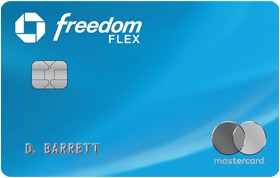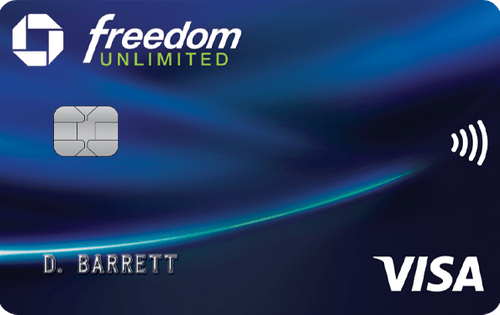The Freedom credit cards are one of Chase’s signature suite of cards, consisting of the Chase Freedom®, Chase Freedom Unlimited® and the new Chase Freedom Flex℠. These cards are known for having no annual fee, cash-back rewards and generous welcome bonuses.
Since the Freedom card recently closed to new applicants, prospective Freedom cardholders have the option to apply for either the Unlimited or Flex cards. Both options are strong choices for consumers with good or excellent credit (scores 670 or higher) and offer robust rewards rates on eligible travel, dining and drug store purchases.
However these cards differ when it comes to rotating reward categories and the amount of cash back you earn on everyday purchases. If you’re in the market for a new card and considering Freedom, review what sets these cards apart, so you can choose the one that provides the most benefit for your spending habits.
Chase Freedom Flex vs. Chase Freedom Unlimited
| Chase Freedom Flex | Chase Freedom Unlimited | |
|---|---|---|
| Annual fee | $0 | $0 |
| Regular APR | 14.99% to 23.74% variable | 14.99% to 23.74% variable |
| Intro APR | 0% for the first 15 months on purchases | 0% for the first 15 months on purchases |
| Rewards | 5% cash back on grocery store purchases (not including Target or Walmart purchases) on up to $12,000 spent in the first year, 5% cash back on up to $1,500 in combined purchases in bonus categories each quarter you activate (then 1%), 5% cash back on travel booked through the Chase Ultimate Rewards® portal, 3% cash back on dining and at drug stores, 1% cash back on all other purchases | 5% cash back on grocery store purchases (not including Target or Walmart purchases) on up to $12,000 spent in the first year, 5% cash back on travel booked through the Chase Ultimate Rewards® portal, 3% cash back on dining and at drug stores, 1.5% on all other purchases |
| Welcome bonus | $200 cash back after you spend $500 on purchases in your first 3 months from account opening | $200 cash back after you spend $500 on purchases in your first 3 months from account opening |
Rewards
The Flex and Unlimited have some cash-back rates that overlap, while they differ in other areas. Both cards offer:
- 5% cash back on travel booked through the Chase Ultimate Rewards® portal
- 3% cash back on dining and at drug stores
Flex also offers 5% cash back on up to $1,500 in combined purchases in bonus categories each quarter you activate (then 1%) and 1% cash back on all other purchases. Bonus categories for October through December are Walmart and PayPal. Check out the full Chase Freedom cash-back calendar for more rewards information.
Unlimited doesn’t have rotating bonus categories and instead offers 1.5% cash back on all other purchases.
In addition to cash-back rewards, Flex and Unlimited offer the same two-tier welcome bonus:
- Earn $200 cash back after you spend $500 on purchases in your first three months from account opening.
- Earn 5% cash back on grocery store purchases (not including Target® or Walmart® purchases) on up to $12,000 spent in the first year.
CNBC Select used a sample spending budget based on the latest data available from the location intelligence firm Esri to break down how much money you would earn using each card over the course of five years, after the cost of the annual fee.
For the average consumer, you could earn up to $2,647 in rewards using Freedom Flex over a five-year period. With Freedom Unlimited you could earn up to $2,709. These estimates incorporate the cash back earned from the welcome bonus.
Winner: Freedom Unlimited has a slight lead on Flex by providing roughly $62 more in potential cash back over a five-year period.
Additional perks
The Freedom Unlimited and Flex cards are backed by different networks, which means they come with slightly different suites of benefits. Freedom Unlimited has the backing of the Visa network, whereas Freedom Flex is backed by Mastercard.
Unlimited cardholders receive either a Visa Platinum or a Visa Signature card, depending on creditworthiness. These tiers offer similar benefits, such as extended warranty protection, auto rental collision damage waiver, Visa shopping discounts and more.
Flex cardholders can take advantage of World Elite Mastercard perks, which provide more premium benefits, including cell phone protection. That’s in addition to extended warranty protection, auto rental collision damage waiver, Mastercard Priceless experiences and more.
Chase also provides these limited-time promotions on both cards:
- Earn 5% cash back on Lyft rides through March 2022.
- Receive a complimentary three months of DashPass, which provides free delivery and lower service fees from hundreds of restaurants on DoorDash orders of $12 or more. After that, you’re automatically enrolled in DashPass at 50% off for the next nine months, unless you cancel. (You must activate by December 31, 2021.)
Winner: Flex edges out Unlimited thanks to its potentially money-saving cell phone protection benefit. This perk is uncommon among credit cards and a great asset of this card.
Fees
The Freedom cards both have the same fee structure. Cardholders will benefit from no annual fee and a 0% APR for the first 15 months on purchases (then a 14.99% to 23.74% variable APR). There is currently no balance transfer offer on either card, so any transfers will incur the regular APR and a 5% fee ($5 minimum).
These cards aren’t ideal for traveling abroad since there is a 3% foreign transaction fee. If you frequently travel outside the U.S., consider another Chase card with no foreign transaction fee like the Chase Sapphire Preferred® Card.
Winner: It’s a tie since both cards have the same fees.
Bottom line
The Chase Freedom Flex and Chase Freedom Unlimited are two competitive cash-back credit cards. Both cards offer a money-saving no annual fee, plus similar cash-back rates. But while these cards rank neck-and-neck, the best option for you depends on whether you prefer to earn more cash back or take advantage of added perks.
If cash back is what you’re looking for, Unlimited is the better choice. While the five-year difference in cash-back earnings is relatively insignificant — Unlimited beats Flex by roughly $62 — that may be enough for you to opt for Unlimited. Plus Unlimited has a simpler cash-back program that doesn’t require you to activate bonus categories.
However, if $62 isn’t a deal breaker, you should consider the Flex card and its array of benefits like cell phone protection. When you pay your monthly cell phone bill with your card, you may receive reimbursement for damaged or stolen phones listed on your bill up to $800 per claim and $1,000 per year. (There’s a maximum of two claims per 12-month period and a $50 deductible per claim.) This perk alone can add up to significant savings if you often incur charges from cell phone damage.
Extreme credit card optimizers may even want to consider opening both cards and maximizing cash-back rewards. This can be a good choice for someone who wants to earn up to 5% cash back on bonus category purchases (Flex) and 1.5% cash back on every day purchases (Unlimited). And since both Freedom cards earn cash back in the form of Chase Ultimate Rewards points, you can transfer Ultimate Rewards points between other eligible Chase cards, like the Chase Sapphire Preferred.
Chase Freedom Flex℠

On Chase’s secure site
-
Rewards
5% cash back on grocery store purchases (not including Target® or Walmart® purchases) on up to $12,000 spent in the first year, 5% cash back on up to $1,500 in combined purchases in bonus categories each quarter you activate (then 1%), 5% cash back on travel booked through the Chase Ultimate Rewards® portal, 3% cash back on dining and at drug stores, 1% cash back on all other purchases
-
Welcome bonus
$200 cash back after you spend $500 on purchases in your first 3 months from account opening
-
Annual fee
-
Intro APR
0% for the first 15 months on purchases
-
Regular APR
14.99% to 23.74% variable
-
Balance transfer fee
Either $5 or 5% of the amount of each transfer, whichever is greater
-
Foreign transaction fee
-
Credit needed
Pros
- No annual fee
- Generous welcome bonus
- Opportunity to earn up to 5% cash back in select categories upon activation
- Rewards can be transferred to a Chase Ultimate Rewards card
- Long intro 0% APR period for purchases
Cons
- Bonus categories must be activated each quarter
- 3% fee charged on foreign transactions
- Estimated rewards earned after 1 year: $814
- Estimated rewards earned after 5 years: $2,647
Rewards totals incorporate the cash back earned from the welcome bonus
Chase Freedom Unlimited®

On Chase’s secure site
-
Rewards
Earn 5% cash back on grocery store purchases (not including Target or Walmart purchases) on up to $12,000 spent in the first year, 5% cash back on travel purchased through Chase, 3% on dining, including takeout, and drugstores and 1.5% on all other purchases
-
Welcome bonus
$200 cash back after you spend $500 on purchases in your first 3 months from account opening
-
Annual fee
-
Intro APR
0% for the first 15 months on purchases
-
Regular APR
14.99% to 23.74% variable on purchases and balance transfers
-
Balance transfer fee
Either $5 or 5% of the amount of each transfer, whichever is greater
-
Foreign transaction fee
3% of each transaction in U.S. dollars
Pros
- No annual fee
- Long intro 0% APR period for purchases
- Rewards can be transferred to a Chase Ultimate Rewards card
- Generous welcome bonus
Cons
- Below average 1.5% cash back on non-bonus category purchases
- 3% fee charged on foreign transactions
- Estimated rewards earned after 1 year: $847
- Estimated rewards earned after 5 years: $2,709
Rewards totals incorporate the cash back earned from the welcome bonus
Our methodology
To determine which credit cards offer the best value, CNBC Select analyzed popular credit cards available in the U.S. We compared each card on a range of features, including rewards, welcome bonus, introductory and standard APR, balance transfer fee and foreign transaction fees, as well as factors such as required credit and customer reviews when available. We also considered additional perks, the application process and how easy it is for the consumer to redeem points.
CNBC Select teamed up with location intelligence firm Esri. The company’s data development team provided the most up-to-date and comprehensive consumer spending data based on the 2019 Consumer Expenditure Surveys from the Bureau of Labor Statistics. You can read more about their methodology here.
Esri’s data team created a sample annual budget of approximately $22,126 in retail spending. The budget includes six main categories: groceries ($5,174), gas ($2,218), dining out ($3,675), travel ($2,244), utilities ($4,862) and general purchases ($3,953). General purchases include items such as housekeeping supplies, clothing, personal care products, prescription drugs and vitamins, and other vehicle expenses.
CNBC Select used this budget to estimate how much the average consumer would save over the course of a year, two years and five years, assuming they would attempt to maximize their rewards potential by earning all welcome bonuses offered and using the card for all applicable purchases. All rewards total estimations are net the annual fee.
While the five-year estimates we’ve included are derived from a budget similar to the average American’s spending, you may earn a higher or lower return depending on your shopping habits.
Editorial Note: Opinions, analyses, reviews or recommendations expressed in this article are those of the CNBC Select editorial staff’s alone, and have not been reviewed, approved or otherwise endorsed by any third party.